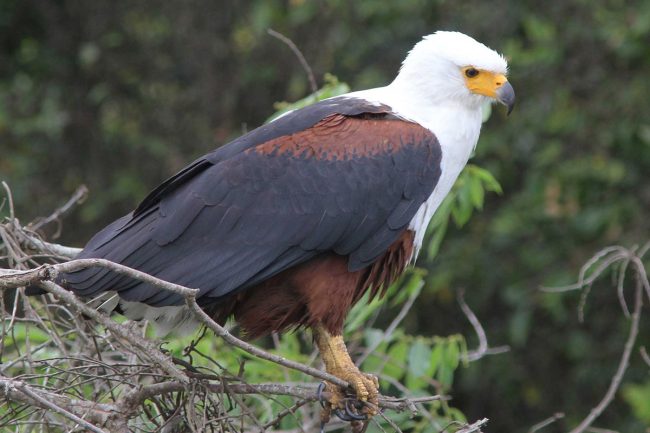Birding in Lake Mburo National Park is an exclusively immersive tour experience that allows visitors to spot a diverse range of bird species while exploring unique ecosystems. Lake Mburo National Park, the smallest savannah park in Uganda spans over 260 square kilometers in the southwest of the country. Lake Mburo National Park is endowed with a number of habitats for at least 330 bird species to thrive. These habitats include savannah grassland, papyrus wetland, Rubanga forest, lakes including Mburo and acacia woodlands.
Birds to see while birding in Lake Mburo National Park
Lake Mburo National Park is a bird haven, where both resident and migratory bird species have been observed in the various habitats mentioned above. These colorful creatures include among others, papyrus gonolek, African finfoot, white collared barbet, blue-headed coucal, bare-faced go-away bird, black-bellied bustard, yellow-rumped tinkerbird, shoebill, brown-chested lapwing, grey crowned crane, Abyssinian ground hornbill, saddled-billed stork, southern ground hornbill, rufous-bellied heron and greater-painted snipe.
Other activities in Lake Mburo National Park
Besides nature walks, the guided birding tours in Lake Mburo National Park can also be experienced during a horseback ride, biking tour, saltlick walk, boat cruise and game drive among other activities. With almost 70 species of mammals, visitors can enjoy their wildlife viewing experiences by encountering the zebra, giraffe, elephant, buffalo, eland, topi, hippo, leopard and hyena etc. Photography and sightseeing are so special in Lake Mburo National Park, thanks to its lovely scenery, including rugged hills, lakes and the savannah wilderness.
Best time for birding in Lake Mburo National Park
Birding in lake Mburo National Park can be done all year round, but if you prefer your encounter to include numerous migratory species of birds, visit from November to April. However, it is important to know that Uganda experiences two distinct weather conditions, which might affect your tour experience—dry and rainy season. During the dry season, the days are warmer and dry, which create favorable conditions to pass on the park trails/tracks. This season occurs during mid-December to February and from June to early-September.
The rainy season, which causes a lot of rains to fall in Lake Mburo National Park creates conditions like abundant water and food sources that are ideal for numerous birds to thrive. This provides a worthwhile birding tour since visitors are guaranteed to spot numerous colorful bird species in Lake Mburo National Park. But the intense rains also affect birding tours by delaying the adventure, as well as creating muddy and slippery trails/tracks that affect hiking in the park. The rainy season is experienced during March to May and October to November.
How to get to Lake Mburo National Park for birding
Traveling to Lake Mburo National Park for a birding tour can easily be done by either road or air. From Kampala city, Lake Mburo National Park is just slightly over 230 kilometers by road south westwards. Your breathtaking journey using Kampala, Masaka and Mbarara routes takes about 5 hours. Private means of transportation that offer both comfort and flexibility are available from reputable tour operators especially Monteero Safaris. Our unparalleled car-hire service includes vehicles like 4X4 safari vehicles, saloon cars and drones etc.
You can also take a quick and convenient flight from Entebbe International Airport to Mbarara Airstrip. AeroLink offers domestic flights that take around 45 minutes with guarantees of aerial views during the journey. From Mbarara, you will have to organize ground transportation to Lake Mburo National Park through Nshara gate. This takes 1.5 hours, covering approximately 70 kilometers via Mbarara-Masaka road. Booking the flight and ground transportation can be done with Monteero Safaris for you to simply enjoy your travel experience.
Some facts about Lake Mburo National Park
Lake Mburo National Park was originally gazetted in 1933 as a controlled hunting area, but later upgraded to a game reserve in 1963. Later, it was designated as a national park in 1983. Its nearest city is Mbarara and it is the closest national park to Kampala, the capital of Uganda. At altitude of 1220 meters to 1,828 meters above seas level and being close to the equator, Lake Mburo National Park experiences both rainy and dry seasons each year. Rainfall received per year in is 800 millimeters on average. Average temperature per year is 27.5oC.
What to pack for birding in Lake Mburo National Park
A well-planned birding tour in Lake Mburo National Park should be complimented with the following essential items,
- Neutral colored light clothes preferably long-sleeved shirt and long trousers. These offer comfort during warm weather conditions. In addition, they protect your skin from insect bites and scratches from thorny flora
- Strong hiking shoes with ankle support to traverse on rugged terrain
- Camera with extra batteries to take excellent shots of the birds
- Pair of binoculars to view birds quite far from you
- UV-protection sunglasses
- UV-protection suncream
- Basic first aid kit
- Wide-brimmed hat
- Light rain jacket
- Recyclable water bottle to quench your thirst whenever dehydrated
- Insect repellent
- Light waterproof backpack
- GPS

